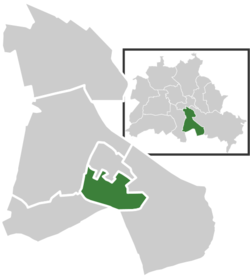Gropiusstadt
Gropiusstadt | |
|---|---|
 Overview of the Gropiusstadt Complex | |
| Country | Germany |
| State | Berlin |
| City | Berlin |
| Borough | Neukölln |
| Founded | 1960 |
| Area | |
| • Total | 2.66 km2 (1.03 sq mi) |
| Elevation | 52 m (171 ft) |
| Population (2008-06-30) | |
| • Total | 35,844 |
| • Density | 13,000/km2 (35,000/sq mi) |
| Time zone | UTC+01:00 (CET) |
| • Summer (DST) | UTC+02:00 (CEST) |
| Postal codes | (nr. 0805) 12351, 12353 |
| Vehicle registration | B |
| Website | Official website |
Gropiusstadt is a locality (Ortsteil) within the Berlin borough (Bezirk) of Neukölln. It was named after the architect who projected the complex: Walter Gropius.
History
Building of the quarter, initially named Britz-Buckow-Rudow and projected in a modernist style by Walter Gropius,[1] ended in 1960. In Berlin, Gropius also projected the Sommerfeld House, the Interbau and the Großsiedlung Siemensstadt quarter. As part of West Berlin, its borders with Brandenburg (part of East Germany) were crossed by the Berlin Wall from 1961 to 1989. As of 2001 it was still an autonomous Ortsteil.[2]
It became famous as the place in which the German writer Christiane F. lived from childhood to adolescence,[3] author of the novel "Wir Kinder vom Bahnhof Zoo".
Geography
Gropiusstadt is located in the eastern suburb of Berlin and a small part of it (the easternmost one) borders with Schönefeld, a municipality in Dahme-Spreewald district, Brandenburg. It borders with the Berlin localities of Britz, Rudow and Buckow. This locality also separates Buckow from its northern exclave, a zone named Buckow-II.
Transport
As urban rail, the locality is served by 4 U-Bahn stations, all located on the U7 line: Johannisthaler Chaussee, Lipschitzallee, Wutzkyallee and Zwickauer Damm.[4]
Photogallery
-
Panoramic view
-
The shopping mall
"Gropius-Passagen" -
Apartment house
References
External links
![]() Media related to Gropiusstadt at Wikimedia Commons
Media related to Gropiusstadt at Wikimedia Commons




